10 Best Welding Helmets in 2022
The Right Welding Helmet Will Protect Your Eyes and Keep You Safe
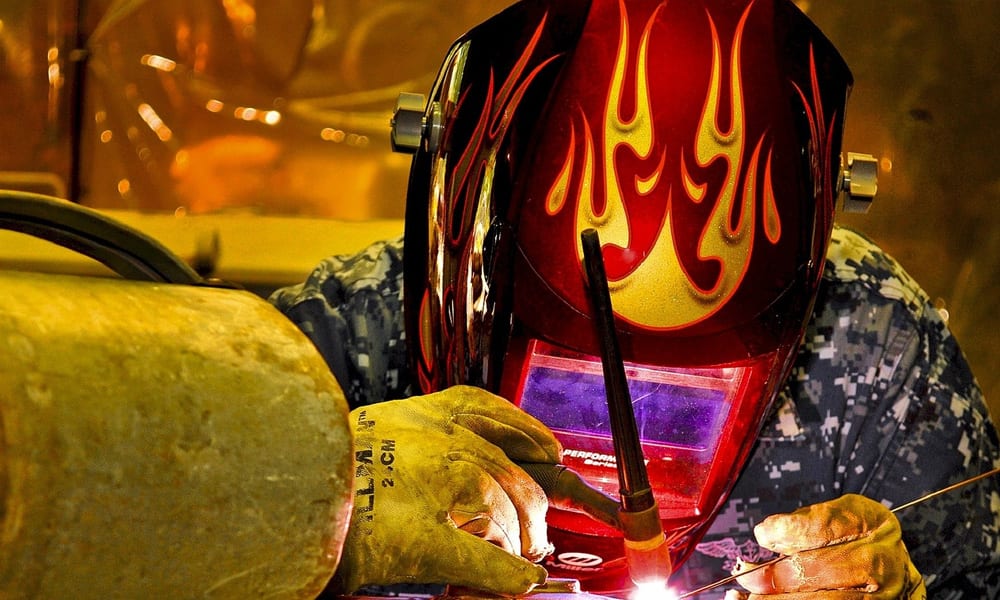
No matter how often you weld, whether on a daily basis or just occasionally, you need to protect yourself and ensure you have the right safety gear. In fact, a good welding helmet should be a priority for you. It will help protect your retinas from the harmful UV and IR rays that emanate from the arc. These UV and IR rays can be extremely damaging. They not only cause serious eye problems but could even cause blindness if you suffer prolonged exposure. Anyone who has ever experienced an arc flash will definitely know what we’re talking about.
So, whether you’re a welding professional, a farmer, a home handyperson, or a welding trainee, you need to ensure that buying the best quality welding helmet is at the top of your list. There are literally hundreds of different welding helmets on the market today. This can make your choice extremely confusing and time-consuming. This confusion can become even more daunting if you’re just starting out and learning to weld.
That’s why our talented team has done all the hard work for you. We’ve researched the most popular welding helmets on the market today to give you a selection of what we think are the top 10 best welding helmets. Through our research, we’ve looked at all the different features and what they do. We’ve also perused hundreds of welding helmet reviews from buyers, both good and bad so that we can let you know both the best features and those that may need improving.
We’ve also constructed a comprehensive buying guide, fully educating you on all the different features to look for when purchasing the best welding helmet for your needs. To start with, here are the 10 best welding helmets we’ve found.
You may be interested in Best MIG Welders.
View the Best Welding Helmet, Below.
- YESWELDER LYG-M800H Welder Mask
- ESAB Sentinel A50 Welding Helmet
- Antra AH6-260 Auto Darkening Welding Helmet
- Lincoln Electric VIKING 3350 Welding Helmet (K3034-4)
- Hobart 770890 Auto-Darkening Welding Helmet
- Jackson Safety 46131 Welding Helmet
- DEKOPRO MZ-225 Blue Eagle Welding Helmet
- Dewalt Wide View Auto-Darkening Welding Helmet
- Lincoln Electric K3419-1 W/Grind ADF Helmet
- Metal Man Auto AB8100SC Darkening Welding Helmet
1. YESWELDER LYG-M800H Welder Mask
Best Welding Helmet With True Color View

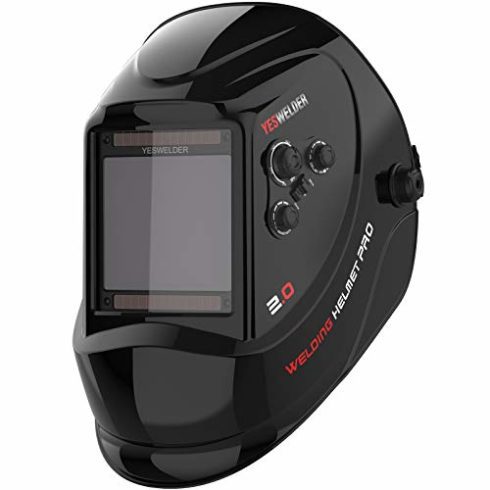
This welding helmet is ideal for Tig, Mig, MMA, and Plasma applications and comes with a grinding mode. It features True Color Technology that helps to improve visibility and reduces eye strain. The pivot style headgear ensures that the helmet fits comfortably. It uses a lithium-ion battery with an average battery life of 3000 hours. The lens shade range is also very adequate for most types of welding.
Why We Liked It: With this welding helmet, you'll get better clarity because it reduces the lime green tint while welding. Plus, the large screen gives you a larger view of your work area. There's also an oversized comfort cushion in the headgear with fully adjustable settings. This ensures a comfortable fit, especially when you're doing a lot of welding. The high number of arc sensors means that this helmet is suitable for almost every welding process.
Check Price on Amazon ➞2. ESAB Sentinel A50 Welding Helmet
Best Welding Helmet with a Touch Screen
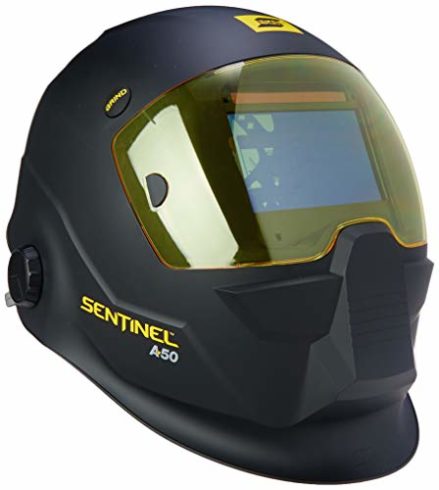
This ESAB Sentinel A50 helmet features an ergonomic headgear design to provide excellent comfort during extended wear. It also has an LCD control panel that you operate via a touch screen. In addition, the ultra-clear true-color lens means that you have a clear view of your welding area.
Why We Liked It: This ESAB Sentinel A50 welding helmet is lightweight at only 1.4 pounds. It features headgear that has 5 different adjustment points to give you the best possible fit. The screen features a true-color blue view, giving you clear visibility when you're welding.
Check Price on Amazon ➞3. Antra AH6-260 Auto Darkening Welding Helmet
Best Value-For-Money Welding Helmet
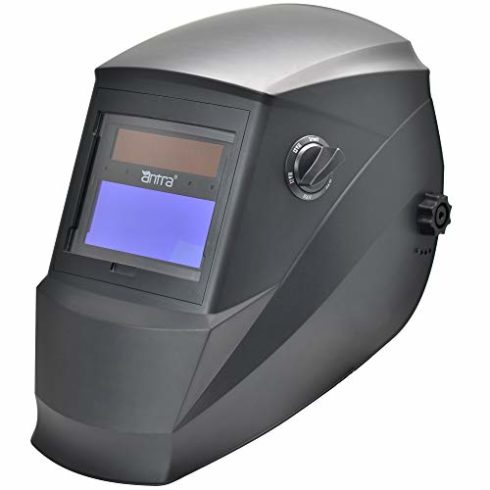
This Antra AH6 welding helmet is suitable for professional welders as well as DIYers. It provides full neck and head protection to guard against flying particles and spatters. It's also compatible with a magnifying lens that's sold separately.
Why We Liked It: This welding helmet is extremely lightweight with auto-darkening and adjustable sensitivity and delay settings. It can move from dark to light in 0.1-1 seconds. The helmet is also reasonably durable as it's made from high-impact polyamide nylon.
Check Price on Amazon ➞VIEW ON HOME DEPOT ➞
4. Lincoln Electric VIKING 3350 Welding Helmet (K3034-4)
Best Overall Auto-Darkening Welding Helmet
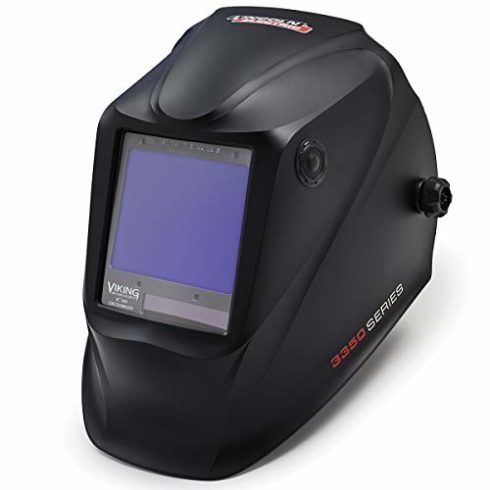
This Lincoln Electric 3350 welding helmet features an auto-darkening lens with 4C lens technology. It's a good welding helmet in this price range. The padded headband is rotatable to give you a comfortable fit, and it's easy to adjust. The Lincoln Electric Viking 3350 welding helmet also features a flexible cushioned back pad. Even though the helmet is a little weighty, the headgear ensures a comfortable fit by distributing the weight over 6 key contact points.
Why We Liked It: The optical clarity rating of the Lincoln Electric 3350 welding helmet reduces lens imperfections such as distortion and blurriness. It provides consistent performance and brightness at any angle. The larger lens viewing area also means greater productivity along with extra safety. It also has a variable shade range from 5 to 13.
Check Price on Amazon ➞5. Hobart 770890 Auto-Darkening Welding Helmet
Best Welding Helmet with Large Viewing Area
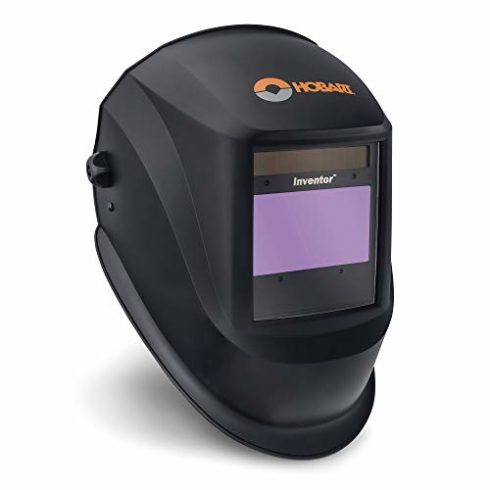
This auto-darkening helmet has a large viewing area to give you increased visibility. It also has four arc sensors and a grind mode. You can use the helmet with a clear screen when grinding instead of welding. The shade range on this helmet is perfect for most types of welding.
Why We Liked It: This is a nice lightweight welding helmet featuring auto-darkening and a grind mode. It uses lithium batteries that are easy to replace. The light sensor is quite sensitive, and the headgear is comfortable to wear even for extended periods of time.
Check Price on Amazon ➞TRACTOR SUPPLY CO ➞
6. Jackson Safety 46131 Welding Helmet
Best Lightweight Welding Helmet
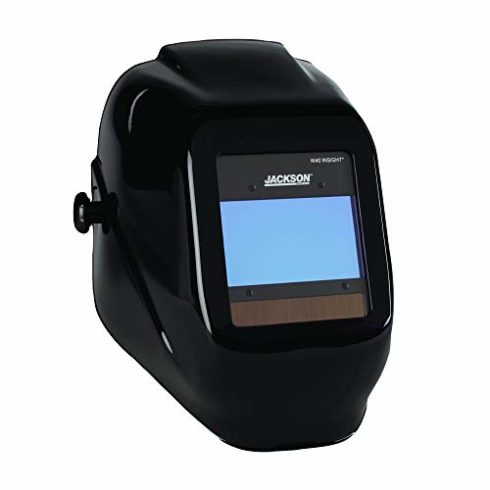
This Jackson Safety welding helmet is super lightweight; the shell only weighs 6 ounces. This reduces the strain on your neck if you're welding for lengthy periods. The auto-darkening helmet has four arc sensors and a reasonably large viewing area. It's also compatible with a magnifying lens, and the shade range is suitable for most types of welding.
Why We Liked It: This is one of the most lightweight welding helmets on the market. It's made by Jackson Safety, who are well known for their innovative safety equipment solutions. The helmet is completely compatible with the Jackson Safety 370 headgear to provide extra comfort for both hobby and professional welders. It uses 2 lithium batteries and supports a long battery life.
Check Price on Amazon ➞7. DEKOPRO MZ-225 Blue Eagle Welding Helmet
Best Budget Welding Helmet for Hobbyists
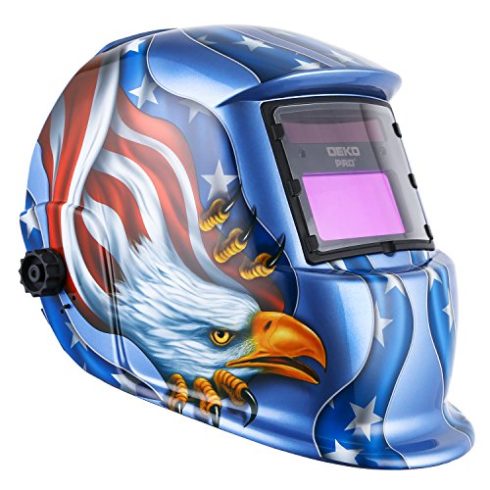
This auto-darkening welding helmet from Dekopro is solar powered with backup provided by 1 lithium battery. It's lightweight with multiple headgear adjustments. The welding helmet also features both adjustable sensitivity and delay settings with a shade range suitable for most welding jobs.
Why We Liked It: This is a lightweight auto-darkening welding helmet at a budget price perfect for welding students and DIYers. It's suitable for MIG, Arc, and TIG welding. It features a colorful blue eagle design that will make you stand out from the crowd.
Check Price on Amazon ➞8. Dewalt Wide View Auto-Darkening Welding Helmet
Best Panoramic Welding Helmet
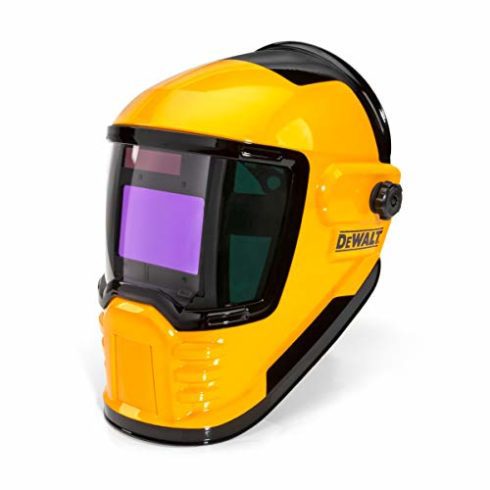
This Dewalt solar-powered welding helmet offers a panoramic viewing area with DIN 5 side lenses. This gives you a large 20.4 square inch viewing area. The helmet also features independent variable shade range control, so you can easily fine-tune the DIN level. This allows you to set the shade range in line with the work you're performing.
Why We Liked It: The viewing area on this Dewalt welding helmet is massive compared to many others in this price range. It gives you the ability to see clearly when you're working, even through your peripheral vision. The optical rating for the auto-darkening lens is 1/1/1/2.
Check Price on Amazon ➞VIEW ON HOME DEPOT ➞
9. Lincoln Electric K3419-1 W/Grind ADF Helmet
Best Budget Welding Helmet
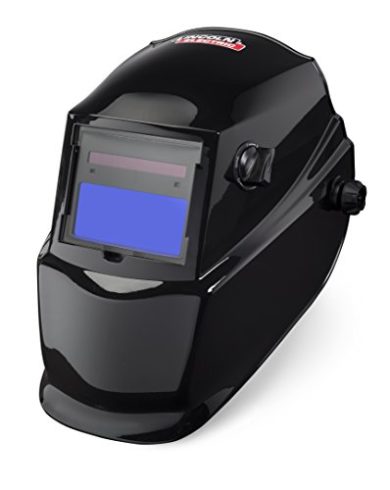
This is an excellent budget welding helmet from Lincoln Electric. It features adjustable headgear for extra comfort. There's also a wide sweatband for the days you're wearing the helmet for extended periods. The helmet is solar powered with 2 AAA backup batteries.
Why We Liked It: This is an affordable welding helmet that does what it's designed to do. It'll protect your eyes while welding. The helmet is durable and uses standard AAA batteries that are easy to replace. The variable shade range is also good for a helmet in this price range.
Check Price on Amazon ➞VIEW ON HOME DEPOT ➞
10. Metal Man Auto AB8100SC Darkening Welding Helmet
Best Solar-Powered Welding Helmet
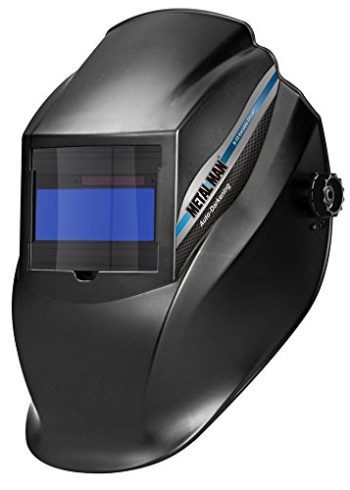
This Metal Man auto-darkening welding helmet uses two CR1025 batteries. This initiates darkening - the lens will darken with solar power from the welding arc light. The helmet is also suitable for TIG welding with a 10 amp rating. The variable shade controls are on the inside of the helmet.
Why We Liked It: This auto-darkening welding helmet has three internal shade sensitivity and delay dials to adjust sensitivity, shade range, and darkening delay. It also has a low battery light, so you know exactly when to change the batteries. The headgear is completely adjustable so you get a comfortable fit.
Check Price on Amazon ➞TRACTOR SUPPLY CO ➞
Best Welding Helmet Buying Guide
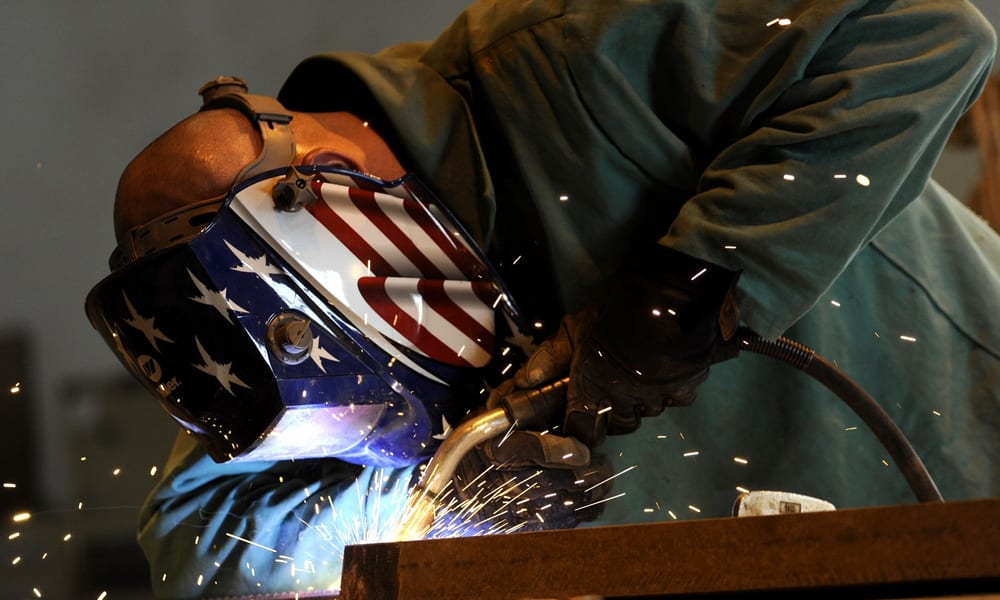 When choosing the best welding helmet for your needs, there are a lot of variables you’ll need to consider. For example, do you want an auto-darkening helmet? What type of welding will you be doing? Will you be welding in a workshop or out in the bright sunlight?
When choosing the best welding helmet for your needs, there are a lot of variables you’ll need to consider. For example, do you want an auto-darkening helmet? What type of welding will you be doing? Will you be welding in a workshop or out in the bright sunlight?
The answer to these questions will determine the type of welding helmet that’s suitable for your needs. So, let’s take a look at the most prominent features that differentiate one welding helmet from another.
Coverage
How much coverage your welding helmet provides is very important. You want to consider whether the helmet covers your face, scalp, ears, and neck area. For example, if the welding helmet doesn’t cover a large portion of your neck area, then sparks from the weld could easily fly down into the front of your clothes, especially if you’re not wearing other items of protective clothing.
Therefore, you need to consider the type of welding you’ll be doing and what other protective gear you’ll need to wear.
Shade Range
The shade range refers to the number of shade darknesses the welding helmet will allow you to set. The higher the shade number, the darker the lens will be. For example, the most common shade range for auto-darkening welding helmets is 9 to 13. This is measured in DIN – a German Industrial standard that measures light filtering levels.
To explain this further, welding helmets with a grind mode allow the lens shade to be light enough so you can see clearly but still have some protection from the brightness of the sparks. In grind mode, the DIN shade would be 3 to 4. At DIN shade 3, only 14% of the visible light in your work area can shine through, while DIN shade 4 only allows 5% of the light to show.
On the other hand, you want to ensure that the darkest shade is selected for arc welding. For example, DIN shade 9 allows 0.037% light transmission, while DIN shade 13 only allows 0.00072% of light transmission. This will ultimately protect you from the damaging UV rays that a welder produces.
Lens Clarity
You want to ensure that you can see what you’re doing when the lens has darkened. Welding is quite precise work, so you need to be able to see as clearly as possible.
This is referred to as optical clarity and is measured with four different categories. These categories are allocated a number from 1 to 3. Number 1 gives you the absolute best clarity. So, when you’re looking at the lens clarity of each welding helmet, it will be displayed as 1/1/1/1 (or a different combination of these numbers). You want to select a helmet that is as close to 1/1/1/1 as possible.
Auto-Darkening Welding Helmets
Auto-darkening welding helmets are now widely available and are preferred by most welders. You can see what you’re doing, so they make it much easier to set up your work area. This bypasses that feeling of confusion when the sparks stop, and your whole world goes dark until you lift up your helmet.
Auto-darkening works when your lens detects the amount of light that’s directly in front of your eyes. As you set up your work, the lens will be a light shade level so you can see what you’re doing. Then, once you fire a spark, the lens shade will darken automatically to protect your retinas from the bright light.
Once you turn off the spark, the lens shade will lighten again automatically. This puts far less strain on your eyes because they won’t need to adjust to the changing light quite as strenuously.
The best auto-darkening welding helmets are driven by solar power. They also have backup batteries that will power the lens if the helmet hasn’t been used in a while. More often than not, the solar power actually comes from the arc while you’re welding – via a solar cell.
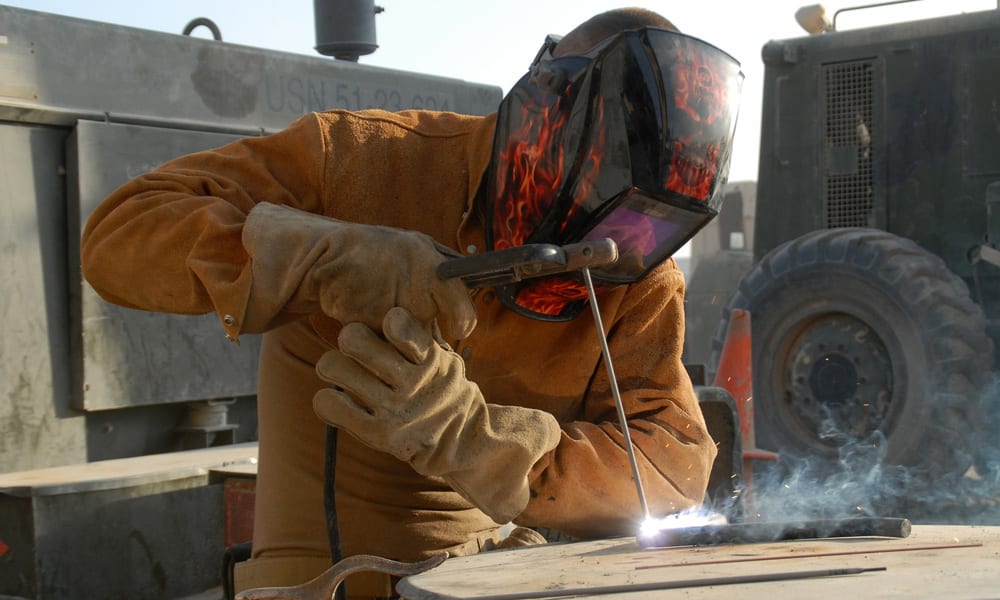
Arc Sensors
The number of arc sensors that a welding helmet has is important when selecting the right helmet for your needs. The arc sensors are designed to detect arc flashes and darken the screen accordingly. This, in turn, will protect your retinas from flashes produced by the arc.
Most welding helmets will have at least two arc sensors, but the best auto-darkening welding helmets will have four sensors. Obviously, the more sensors that the welding helmet has, the better protection it will offer.
A welding helmet with only two sensors may not darken enough if you’re working at a certain angle. The best auto darkening welding helmets have four sensors that will catch a flash no matter the angle you’re working at. These welding helmets also make it less likely for the flash to blind you if other objects are obstructing your view.
Sensitivity Control
One feature you should look for when selecting an auto-darkening welding helmet is sensitivity control. Adjustable sensitivity control allows you to set a brightness value that controls at what level the lens will darken.
This is extremely useful when working at low amperage, such as when you’re TIG welding. You may require a higher sensitivity level because you want the lens to darken at a lower brightness level.
It’s also useful to be able to increase the sensitivity settings when you’re welding outside in the bright sunlight. In this case, you don’t want the lens to darken as soon as you put the helmet on, but you do want protection once you start welding. The best auto-darkening welding helmets will have a good range of sensitivity that you can dial up as needed.
Lens Reaction Time
If you weld a lot, you want to consider a welding helmet with a fast lens reaction time to avoid getting flashed. The lens reaction time is the time it takes for the lens to darken when you strike an arc. The lens reaction time is usually measured as a fraction of a second.
Some of the better auto-darkening helmets will even allow you to set the lens reaction time to suit yourself and the types of welding you do most often.
Viewing Area
The most suitable viewing area for you depends on the types of welding you do. If you only weld small areas directly in front of you, a welding helmet with a smaller viewing area may be suitable.
On the other hand, if you’re constantly welding over a wider area, you’ll need a welding helmet with a larger viewing area. For this purpose, you might want to consider a helmet with a higher viewing area than 2 inches.
For beginners, a larger viewing area around 9 square inches is also good because it means you don’t have to move your head as much to see where the arc is. However, a larger viewing area also means that the helmet is likely to be a little heavier than one with a small viewing area.
Weight
The helmet’s weight becomes more important if you intend to weld continuously for hours at a time. If you have a helmet that’s a little on the heavy side, you may end up with a bit of neck pain.
On the other hand, a lightweight helmet will make your job much easier by reducing fatigue on your neck. This also means you’ll enjoy welding much more because it’s not causing you pain – especially pain that may last for a couple of days.
Does the Helmet Have Grind Mode?
A welding helmet with a grind setting means you can wear it as protection when you’re grinding, but you’ll still be able to see your work. This is because the grind mode doesn’t darken the lens.
This makes your helmet multi-purpose and eliminates the need to constantly change protective gear while you’re welding away in your workshop. Most auto-darkening helmets have a button on the outside that you can use to set the grind feature.
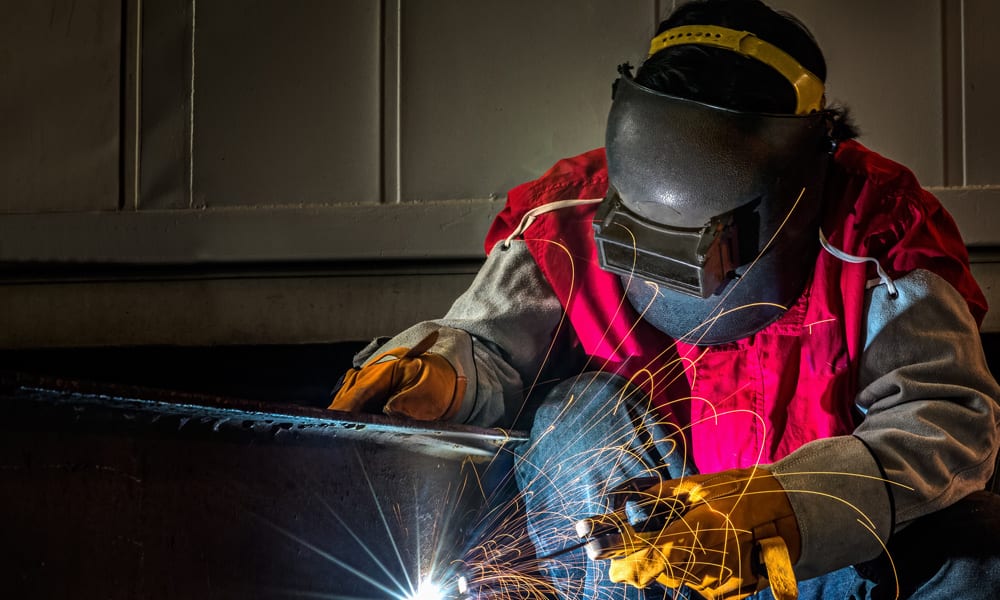
Power Source
Most welding helmets, especially auto-darkening ones, are powered either by solar or batteries. The best welding helmets use both a solar power source and batteries as a backup. Most of these use lithium batteries, but some use standard AAA batteries.
When selecting a welding helmet, it’s important to consider the power source the helmet uses. If you’re constantly welding, then a solar-powered helmet should always remain charged. This is because the helmet will have a solar cell that collects the power from the welding arc.
However, if you only weld occasionally, then it’s far better to choose a helmet that has a battery backup as a power source, so it’s ready for use when you need it.
Another important point to consider is whether the batteries are replaceable. Better welding helmets with an auto dark function should have replaceable batteries. You should also check whether the helmet has an auto-off switch, especially if you won’t be using it for a while. This ensures that the helmet won’t drain the batteries while it’s sitting idle, saving your battery life.
Related: Best Soldering Irons in Review.
Construction Material and Durability
The material that the welding helmet is made from will determine both the helmet’s weight and durability. Most welding helmets are now made from polycarbonate because it’s lightweight and durable enough for most welders. This material is also impact-resistant and heat-resistant. That’s precisely why most welding helmets are now made from this material.
Nylon 66 is another material used by some manufacturers of welding helmets. This is a synthetic polymer that has high durability and toughness. It’s also UV and IR-resistant. This makes Nylon 66 one of the toughest materials for welding helmets.
Comfortable and Adjustable Headgear
When wearing your welding helmet for a long time, you want to ensure it offers a comfortable fit and is fully adjustable. Having to stop and constantly adjust your helmet is both time-consuming and tedious.
Therefore, you want to look for a welding helmet that’s fully adjustable so you can adjust it to get the most comfortable fit. Look for one that has a little padding on the inside or the addition of a sweatband. This will help you keep you nice and comfortable when you’re welding for hours on end.
Is the Helmet Compatible with a Magnifying Lens?
For more delicate welding work, it’s sometimes necessary to add a little magnification. This is where a magnifying or cheater lens can be quite useful. These lenses generally clip onto the inside of the helmet over the viewing area.
Therefore, if your welding process involves very detailed work, you might need to check whether the helmet of your choice is compatible with a magnifying lens. You’ll find that most helmets should have this capability.
Can the Helmet Accommodate a Respirator?
This may not be absolutely vital if you’re a hobbyist or only an occasional welder. However, for professional welders, having a welding helmet that can accommodate a respirator could be quite important.
This is especially the case if you’re working with stainless steel, aluminum, or coated steel. This is primarily because these materials can often give off fumes when heated over a certain temperature.
Price
Although price shouldn’t be your first consideration, it will play a role in which welding helmet you choose. Bear in mind, the more you’re able to pay, the better quality helmet you’re going to get. Also, consider whether you can put a price on the safety of your eyes.
In saying that, there are some good welding helmets in the lower price range. These are generally suitable for beginners or those who only weld occasionally. However, you should consider that these budget welding helmets may not last as long as their more expensive counterparts.
At the other end of the scale, a high-end welding helmet should have all the features you need and should last you for many years. An investment like this could eventually save you money in the long run and ensure that your eyes are well-protected.
Safety Standards
Any welding helmet on the market should meet the safety standard of ANSI Z87.1. This standard for eye protection is set by the American National Standards Institute.
Any helmet that complies will have Z87 stamped on it or, at the very least, marked on the outside of the packaging.
In addition to the ANSI Z87.1 standard, welding helmets will also have further gradings marked on them in relation to the filtration level that they provide. These are as follows:
- A standard welding filter will have “W” on it, followed by a shade level number from 1.3 to 14.
- An ultra-violet filter for UV rays will have “U” followed by a number from 2 to 6.
- An infra-red filter will have “R” followed by a number from 1.3 to 10.
- A visible glare filter will have “L” followed by a number from 1.3 to 10.
In addition, a variable tint will have a “V” on it, and a lens suitable for a special purpose will have an “S” on it.
 Welding Safety
Welding Safety
When considering purchasing a welding helmet, ask yourself why you need it. You know that a helmet will protect your eyes from the brightness of the arc, but why is this necessary? Let’s look at the three different types of light that are emitted when you’re welding.
Visible light. The sheer brightness of the arc can hurt the retinas of your eyes and make you see spots. This is similar to looking directly at the sun or any other very bright light.
Infrared light (IR). This light is invisible but hot and will heat up anything that it comes into contact with.
Ultraviolet light (UV). This is also an invisible light, but continuous exposure can cause burning and skin cell damage.
All welding helmets will protect you from these three types of light. The auto-dark of the welding screen primarily protects you from visible light emitted every time you light an arc. On the other hand, the helmet itself will protect you from the UV and IR wavelengths emitted by a welding arc. This will protect you from getting burned by these UV and IR rays.
Before the invention of auto-darkening helmets, the possibility of damage using a fixed shade helmet with just one shade of darkness was far greater. This is because you had to lift the visor to set up your work before striking an arc. While doing this, you might have accidentally struck the arc and received a blinding flash to your eyes. Additionally, once you put the visor down, you couldn’t see anything until you started the arc. This would have been quite disorienting and was one of the major drawbacks of a fixed shade welding helmet.
Thankfully, auto-darkening helmets have solved this problem. You have full visibility with the visor down before you start welding. Unlike a fixed shade helmet, the lens darkens automatically via a sensor once you strike the arc. This development has made welding much easier and more enjoyable for many people. That’s primarily the difference between passive and auto-darkening helmets.
Passive welding helmets have a fixed shade lens with a darkness level of around 9 or 10, while auto-darkening helmets have a darkness level from around 3 to 10.
How to Clean your Welding Helmet
Keeping your welding helmet clean ensures both the durability and effectiveness of the helmet. This means you’ll improve the longevity of your helmet and ensure that you’re well protected when you’re using it.
Here are some simple methods that professional welders use to keep their helmets as clean as possible.
Wipe Down Your Helmet After Each Use
You should wipe down the surface of your helmet after every use to remove loose debris and dust. You can just use a piece of paper towel to do this, either dry or damp. If you’re using a damp paper towel, make sure you dry the helmet thoroughly with a soft cloth or towel.
Use a Brush to Remove Dirt From Hard-to-Reach Areas
You can simply use a soft brush to remove all the dirt and dust from hard-to-reach areas such as vents and around outer buttons and knobs.
Use an Air Hose to Blow Away Dust
If you have an air pressure hose, you should use this to blow away any remaining dust and debris from all parts of the helmet.
Clean the Auto-Darkening Lens
The most delicate part of an auto-darkening helmet is the actual lens. This requires special care to keep it in optimal condition. You need to ensure that you clean it gently and never use any harsh abrasives.
You can purchase a quality lens cleaner and cleaning wipes for this purpose. Once you’ve cleaned the lens gently, make sure you dry it thoroughly with a piece of paper towel or a soft cloth towel.
Use a Specially Designed Helmet Cleaner
You can clean the outside of your helmet with a specially designed helmet cleaner like Bike Brite MC1900. You should apply this cleaner with a soft cloth, or you can even use baby wipes.
Disinfect Your Helmet Regularly
Disinfecting the inside of your helmet is also important to eliminate any bacteria that may be lurking there. Remember that while you’re welding, it gets hot, and you may start to sweat. This moist environment can attract germs and bacteria.
Therefore, you should use a gentle disinfectant spray to spray the inside of your helmet on a regular basis. Then, make sure you leave the helmet to air dry before using it again.
Use a Soft Towel to Make Sure the Helmet is Completely Dry
Once you’ve thoroughly cleaned your helmet and disinfected it, you can use a soft towel to ensure that it’s completely dry before you store it away.
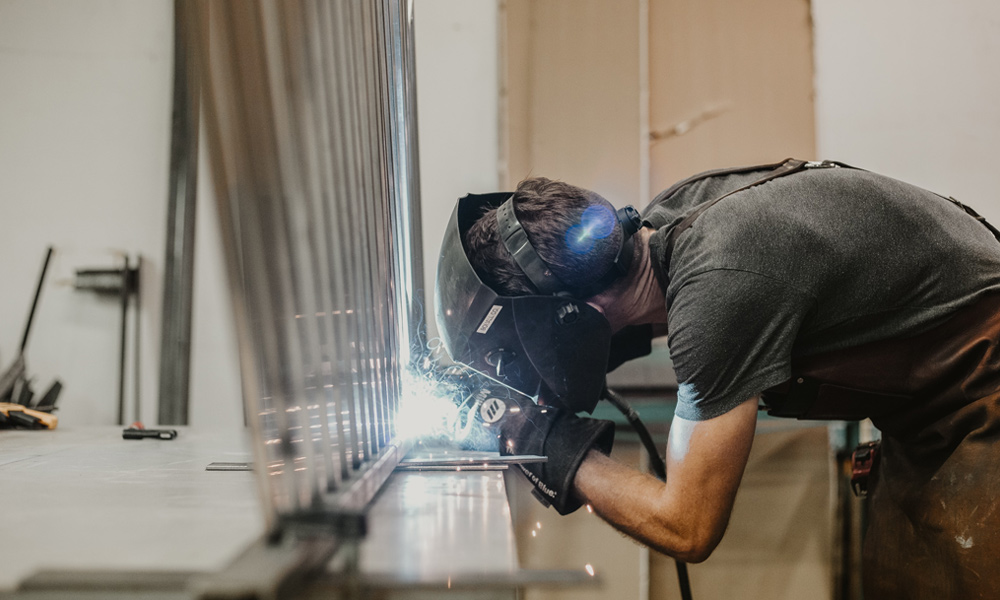 Frequently Asked Questions
Frequently Asked Questions
Let’s look at some questions that are commonly asked by people wanting to buy a welding helmet.
How Long Can You Expect a Welding Helmet to Last?
This depends entirely on the quality and durability of the helmet and how you treat it. And, more often than not, quality depends on price. Therefore, less expensive helmets won’t likely last as long as the pricier ones because they are quite often constructed from thinner or cheaper materials. However, if you only use your less expensive helmet a couple of times a year, it’s likely to last as long as a more expensive unit that gets used on a daily basis.
You’ll also find that the batteries in less expensive helmets will not last as long as those in higher-end units. Batteries in high-quality welding helmets can last as long as seven years. However, those in cheaper helmets may only last a couple of months.
Also, keeping your helmet clean and free from dust and other debris is likely to extend its life.
Can Welders Go Blind Over Time?
It’s possible for a welder to go blind over time, but this is dependent on many factors. Prolonged exposure to the welding arc without proper protection places enormous strain on the eyes.
Are Cheap Welding Helmets Any Good?
This depends entirely on how often you’re going to use the helmet and whether the helmet meets the ANSI standards. Many cheaper welding helmets work very effectively and are mainly suitable if you only have the occasional welding task to do.
However, if you’re planning on doing a lot of welding, you should definitely consider one in the mid to higher price range.
Are Auto-Darkening Welding Helmets Bad For Your Eyes?
When used correctly, welding helmets with an auto-darkening feature are not bad for your eyes and can be more beneficial than passive welding helmets. You just need to ensure that the batteries are fully charged before you start any type of welding. This step ensures that the lens will darken correctly when you strike the arc.
How Do I Know If my Welding Helmet is Safe?
Firstly, you want to ensure that it has an ANSI safety standard (ANSI Z87.1) on the helmet or the packaging. This means that the helmet has been rigorously tested to meet the necessary safety standards.
Here are a couple of other tests that you can do to ensure that the welding helmet you’ve purchased is completely safe to use.
Check the Fit. Make sure the helmet sits securely on your head and that it cannot move around freely. Remember, you have to look through the lens at all times to benefit from the protection it provides for your eyes. Most helmets come with adjustable headgear to ensure a snug fit. Make sure that you spend enough time adjusting this so you get the best possible fit.
Test your Helmet. Before using your helmet for the first time, you should test the auto-darkening lens prior to using it when welding. You can do this outside on a bright, sunny day. This will let you see how quickly the lens darkens when you look into the sun.
As you’re using your helmet, you should consider whether you start to suffer from eye fatigue. This could present itself as headaches, pain in the eyes, and double or blurry vision. If you start to experience these symptoms, it might be time to invest in a better helmet.
It’s also important to check your helmet if you haven’t used it in a while or if it’s been exposed to low temperatures. These instances could result in the deterioration of the helmet and a delay in reaction times. Therefore, be sure to test your helmet’s auto-darkening reaction times if it’s been sitting idle for some time.
Conclusion
A welding helmet is an important piece of safety equipment that no welder should be without. It covers your face and neck and provides your eyes with the essential protection that they need from harmful UV and IV rays. When selecting a welding helmet, consider the purpose you’ll be using it for. If you only weld a couple of times a year, you probably don’t have to invest in an expensive welding helmet.
However, if you’re going to be welding a lot and even every day, you want the best quality helmet you can afford to buy. After all, you can’t put a price on the health of your eyes. The most important features that you want to consider are the shade darkening range, the viewing area, the lens darkening reaction time, and the helmet’s fit. You also want to consider whether the helmet has a grinding mode so you can use it while you’re doing grinding work.
When selecting a suitable helmet, make sure it meets the recommended safety standards; it should have the standards’ mark on the helmet or the packaging. Also, consider the clarity of the lens and the material it’s constructed from.
In addition, if your helmet is solar-powered, make sure it has a battery backup. This means that you don’t have to recharge before use if it’s been sitting idle for some time. Ensure that the batteries are easily replaceable as they can lose their power if left sitting for too long.
Above all, make sure that you look after your helmet once you start using it. The more you care for it, the longer it will last and the more effective it will be.
We hope you’ve found our reviews helpful and that our buying guide has given you all the relevant information you need to make an informed decision before purchasing your new welding helmet.